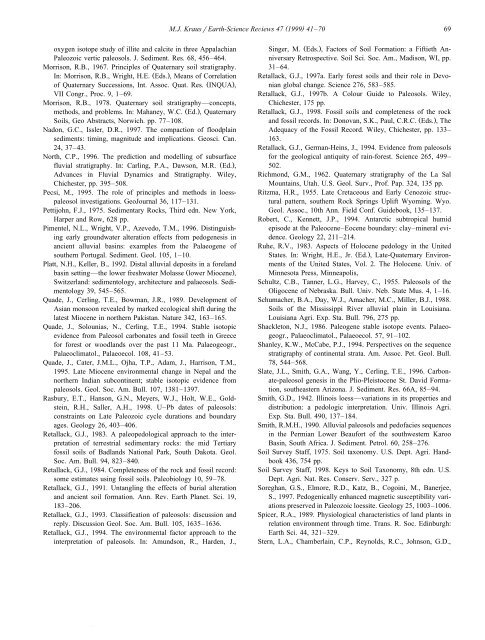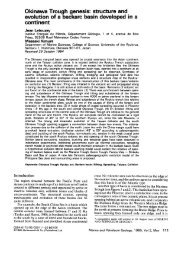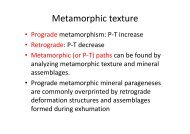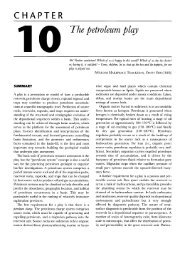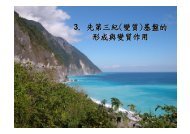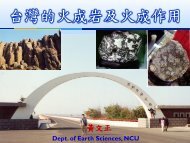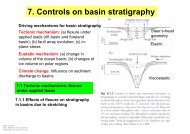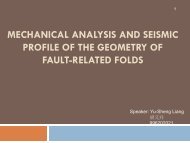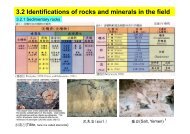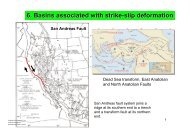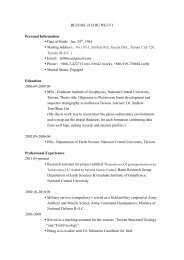Paleosols in clastic sedimentary rocks: their geologic applications
Paleosols in clastic sedimentary rocks: their geologic applications
Paleosols in clastic sedimentary rocks: their geologic applications
- No tags were found...
Create successful ePaper yourself
Turn your PDF publications into a flip-book with our unique Google optimized e-Paper software.
( )M.J. KrausrEarth-Science ReÕiews 47 1999 41–70 69oxygen isotope study of illite and calcite <strong>in</strong> three AppalachianPaleozoic vertic paleosols. J. Sediment. Res. 68, 456–464.Morrison, R.B., 1967. Pr<strong>in</strong>ciples of Quaternary soil stratigraphy.In: Morrison, R.B., Wright, H.E. Ž Eds. ., Means of Correlationof Quaternary Successions, Int. Assoc. Quat. Res. Ž INQUA .,VII Congr., Proc. 9, 1–69.Morrison, R.B., 1978. Quaternary soil stratigraphy—concepts,methods, and problems. In: Mahaney, W.C. Ž Ed. ., QuaternarySoils, Geo Abstracts, Norwich. pp. 77–108.Nadon, G.C., Issler, D.R., 1997. The compaction of floodpla<strong>in</strong>sediments: tim<strong>in</strong>g, magnitude and implications. Geosci. Can.24, 37–43.North, C.P., 1996. The prediction and modell<strong>in</strong>g of subsurfacefluvial stratigraphy. In: Carl<strong>in</strong>g, P.A., Dawson, M.R. Ž Ed. .,Advances <strong>in</strong> Fluvial Dynamics and Stratigraphy. Wiley,Chichester, pp. 395–508.Pecsi, M., 1995. The role of pr<strong>in</strong>ciples and methods <strong>in</strong> loesspaleosol<strong>in</strong>vestigations. GeoJournal 36, 117–131.Pettijohn, F.J., 1975. Sedimentary Rocks, Third edn. New York,Harper and Row, 628 pp.Pimentel, N.L., Wright, V.P., Azevedo, T.M., 1996. Dist<strong>in</strong>guish<strong>in</strong>gearly groundwater alteration effects from pedogenesis <strong>in</strong>ancient alluvial bas<strong>in</strong>s: examples from the Palaeogene ofsouthern Portugal. Sediment. Geol. 105, 1–10.Platt, N.H., Keller, B., 1992. Distal alluvial deposits <strong>in</strong> a forelandbas<strong>in</strong> sett<strong>in</strong>g—the lower freshwater Molasse Ž lower Miocene .,Switzerland: sedimentology, architecture and palaeosols. Sedimentology39, 545–565.Quade, J., Cerl<strong>in</strong>g, T.E., Bowman, J.R., 1989. Development ofAsian monsoon revealed by marked ecological shift dur<strong>in</strong>g thelatest Miocene <strong>in</strong> northern Pakistan. Nature 342, 163–165.Quade, J., Solounias, N., Cerl<strong>in</strong>g, T.E., 1994. Stable isotopicevidence from Paleosol carbonates and fossil teeth <strong>in</strong> Greecefor forest or woodlands over the past 11 Ma. Palaeogeogr.,Palaeoclimatol., Palaeoecol. 108, 41–53.Quade, J., Cater, J.M.L., Ojha, T.P., Adam, J., Harrison, T.M.,1995. Late Miocene environmental change <strong>in</strong> Nepal and thenorthern Indian subcont<strong>in</strong>ent; stable isotopic evidence frompaleosols. Geol. Soc. Am. Bull. 107, 1381–1397.Rasbury, E.T., Hanson, G.N., Meyers, W.J., Holt, W.E., Goldste<strong>in</strong>,R.H., Saller, A.H., 1998. U–Pb dates of paleosols:constra<strong>in</strong>ts on Late Paleozoic cycle durations and boundaryages. Geology 26, 403–406.Retallack, G.J., 1983. A paleopedological approach to the <strong>in</strong>terpretationof terrestrial <strong>sedimentary</strong> <strong>rocks</strong>: the mid Tertiaryfossil soils of Badlands National Park, South Dakota. Geol.Soc. Am. Bull. 94, 823–840.Retallack, G.J., 1984. Completeness of the rock and fossil record:some estimates us<strong>in</strong>g fossil soils. Paleobiology 10, 59–78.Retallack, G.J., 1991. Untangl<strong>in</strong>g the effects of burial alterationand ancient soil formation. Ann. Rev. Earth Planet. Sci. 19,183–206.Retallack, G.J., 1993. Classification of paleosols: discussion andreply. Discussion Geol. Soc. Am. Bull. 105, 1635–1636.Retallack, G.J., 1994. The environmental factor approach to the<strong>in</strong>terpretation of paleosols. In: Amundson, R., Harden, J.,S<strong>in</strong>ger, M. Ž Eds. ., Factors of Soil Formation: a Fiftieth AnniversaryRetrospective. Soil Sci. Soc. Am., Madison, WI, pp.31–64.Retallack, G.J., 1997a. Early forest soils and <strong>their</strong> role <strong>in</strong> Devonianglobal change. Science 276, 583–585.Retallack, G.J., 1997b. A Colour Guide to <strong>Paleosols</strong>. Wiley,Chichester, 175 pp.Retallack, G.J., 1998. Fossil soils and completeness of the rockand fossil records. In: Donovan, S.K., Paul, C.R.C. Ž Eds. ., TheAdequacy of the Fossil Record. Wiley, Chichester, pp. 133–163.Retallack, G.J., German-He<strong>in</strong>s, J., 1994. Evidence from paleosolsfor the <strong>geologic</strong>al antiquity of ra<strong>in</strong>-forest. Science 265, 499–502.Richmond, G.M., 1962. Quaternary stratigraphy of the La SalMounta<strong>in</strong>s, Utah. U.S. Geol. Surv., Prof. Pap. 324, 135 pp.Ritzma, H.R., 1955. Late Cretaceous and Early Cenozoic structuralpattern, southern Rock Spr<strong>in</strong>gs Uplift Wyom<strong>in</strong>g. Wyo.Geol. Assoc., 10th Ann. Field Conf. Guidebook, 135–137.Robert, C., Kennett, J.P., 1994. Antarctic subtropical humidepisode at the Paleocene–Eocene boundary: clay–m<strong>in</strong>eral evidence.Geology 22, 211–214.Ruhe, R.V., 1983. Aspects of Holocene pedology <strong>in</strong> the UnitedStates. In: Wright, H.E., Jr. Ž Ed. ., Late-Quaternary Environmentsof the United States, Vol. 2. The Holocene. Univ. ofM<strong>in</strong>nesota Press, M<strong>in</strong>neapolis,Schultz, C.B., Tanner, L.G., Harvey, C., 1955. <strong>Paleosols</strong> of theOligocene of Nebraska. Bull. Univ. Neb. State Mus. 4, 1–16.Schumacher, B.A., Day, W.J., Amacher, M.C., Miller, B.J., 1988.Soils of the Mississippi River alluvial pla<strong>in</strong> <strong>in</strong> Louisiana.Louisiana Agri. Exp. Sta. Bull. 796, 275 pp.Shackleton, N.J., 1986. Paleogene stable isotope events. Palaeogeogr.,Palaeoclimatol., Palaeoecol. 57, 91–102.Shanley, K.W., McCabe, P.J., 1994. Perspectives on the sequencestratigraphy of cont<strong>in</strong>ental strata. Am. Assoc. Pet. Geol. Bull.78, 544–568.Slate, J.L., Smith, G.A., Wang, Y., Cerl<strong>in</strong>g, T.E., 1996. Carbonate-paleosolgenesis <strong>in</strong> the Plio-Pleistocene St. David Formation,southeastern Arizona. J. Sediment. Res. 66A, 85–94.Smith, G.D., 1942. Ill<strong>in</strong>ois loess—variations <strong>in</strong> its properties anddistribution: a pedologic <strong>in</strong>terpretation. Univ. Ill<strong>in</strong>ois Agri.Exp. Sta. Bull. 490, 137–184.Smith, R.M.H., 1990. Alluvial paleosols and pedofacies sequences<strong>in</strong> the Permian Lower Beaufort of the southwestern KarooBas<strong>in</strong>, South Africa. J. Sediment. Petrol. 60, 258–276.Soil Survey Staff, 1975. Soil taxonomy. U.S. Dept. Agri. Handbook436, 754 pp.Soil Survey Staff, 1998. Keys to Soil Taxonomy, 8th edn. U.S.Dept. Agri. Nat. Res. Conserv. Serv., 327 p.Soreghan, G.S., Elmore, R.D., Katz, B., Cogo<strong>in</strong>i, M., Banerjee,S., 1997. Pedogenically enhanced magnetic susceptibility variationspreserved <strong>in</strong> Paleozoic loessite. Geology 25, 1003–1006.Spicer, R.A., 1989. Physiological characteristics of land plants <strong>in</strong>relation environment through time. Trans. R. Soc. Ed<strong>in</strong>burgh:Earth Sci. 44, 321–329.Stern, L.A., Chamberla<strong>in</strong>, C.P., Reynolds, R.C., Johnson, G.D.,


